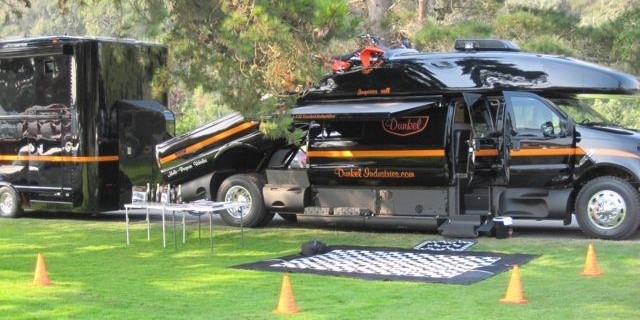Building a motorhome on the modified chassis of a Ford F-750 World Cruiser pick-up is a dream within the reach of very few people. This is the case of Peter Dunkel, an American heavy machinery manufacturer who has invested a whopping six million dollars in a custom motorhome that can accommodate up to six people comfortably.
Among camper and caravan enthusiasts there has always been a great fondness for customizing their vehicles. In our country, this type of customization is very limited, and any transformation or the addition of any non-vehicle element must first have the corresponding approval.
These restrictions are less stringent in the United States, so it is not surprising that some motorhome enthusiasts carry out authentic transformations of their vehicles, thus creating a unique model that hardly resembles the original.
This is the case with the Ford F-750 World Cruiser motorhome, a unique creation owned by car collector Peter Dunkel.
The birth of the beast
The father of the idea carried out the transformation in his company, Dunkel Industries, dedicated in the United States to the production of heavy machinery. Peter Dunkel has invested about six million dollars (5.3 million euros) in the project.
The first step was to lengthen the chassis, turning the F-750 into a behemoth of more than eight meters in length. The transformation also included a 56-centimeter increase in the width of the structure that supports the motorhome.
The weight of the cabin at full load is around 3,600 kg, a requirement that forced the engineers of Dunkel Industries to increase the thickness of the structure that serves as support to 130 mm, making the rear rest on solid and heavy sheet metal.
Interior of FORD F-750 WORLD CRUISER
The exterior dimensions of the World Cruiser are just a preamble to what awaits us in this motorhome. When accessing the interior of this enormous vehicle, we find enough space for six people to sleep comfortably in a vehicle that includes everything necessary for an American getaway, you know, wild nature and epic sunsets.
The interior is lined with carpet whose pattern matches perfectly with the beige leather upholstery that covers the seats, dashboard and doors . Access from the outside is through a side step that is collected during transit.
The living space is divided into several rooms. Upon entering we find an area for the kitchen and living room, which in turn shares space with the driving area . Above this, we find a bedroom with a double bed with glazed sides to enjoy the views.
The full bathroom is separated from the rest by a door , being able to have a hot shower without the need to supply ourselves with propane. The kitchen has a sink, oven and ceramic hob for cooking , as well as a multitude of cabinets for storage.
The rear room of the Ford F-750 (which can be transformed into a room for four people) has a flat screen television to enjoy leisure on our getaways if the day threatens rain .
A look at the exterior of the vehicle shows us more details of the equipment , since you can see an air conditioning module, awning, side storage spaces and something completely surprising: the rear can be raised on a hydraulic system to facilitate the unloading of luggage or even another off-road vehicle .
300 hp Caterpillar engine
How can this 3,600 kg motorhome move with ease? It does so thanks to the enormous power developed by its impressive 300 hp Carterpillar engine with a maximum torque of 1,600 Nm , which allows this almost four-ton monster to reach speeds of up to 110 km / h. Of course, in view of the benefits the fuel tank has a capacity of 230 liters .
Since 2008 this motorhome has been owned by Peter Dunkel and in 2013 it went up for auction although it was never sold due to its high price, above 4,53,096.00 usd.


